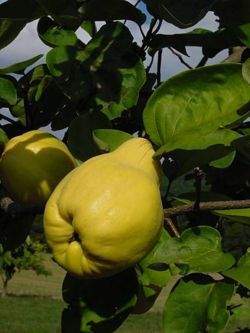Quince
The quince is a small tree or shrub and sole member of the genus Cydonia, family Rosaceae; the name is also used for the fruit of the tree. To quote the Food Lover's Companion:
Ancient Romans used the flowers and fruit of the quince tree for everything for perfume to honey. It was also considered a symbol of love and given to one's intended as a sign of commitment.[1]
Etymologically, the quince is the "fruit from Chaniá", a port on the northwest coast of Crete from which quinces were exported. In ancient times Chaniá was known as Cydonia (in Greek Κυδώνια), so the ancient Greeks called the fruit Κυδώνιον μῆλον ("Cydonian apple"). Latin took the term over as cydōneum, later cotōneum, which passed into English via Old French cooin. The original English form of the word was quoyn, later quyn, but already by the early 14th century its plural quyns was coming to be regarded as a singular. Its geographical origins are unclear—putatively India or Persia—but by 700 BC it was being used by the Greeks as a ritual item in wedding ceremonies.
Quinces are grown under similar conditions to apple and pear trees, and are susceptible to many of the same diseases and pests, such as fire blight and scale insects. It is, however, widely used by commercial growers as a rootstock for grafts of apple and pear trees.
Being naturally high in pectin, the fruit is used mainly for jam, jelly, and preserves, but may also be eaten baked or prepared like other fruits.
References
- ↑ The New Food Lover's Companion, Second Edition, by Sharon Tyler Herbst, Barron's, Hauppauge, New York, 1995, ISBN 0-8120-1520-7, page 640
